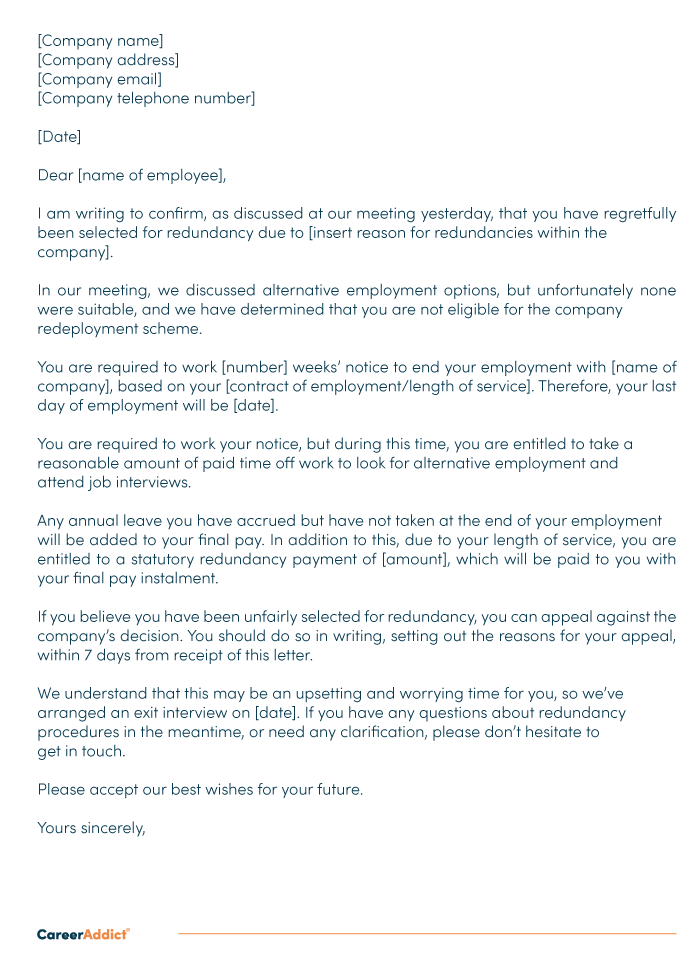Your Rights to Redundancy If Company Goes Bust: UK Employee Protections
Your Rights to Redundancy If Company Goes Bust: UK Employee Protections
Blog Article
Examining the Interplay In Between Company Redundancy and Organizational Flexibility for Future Development
In the dynamic landscape of today's organization globe, the elaborate relationship between company redundancy and business versatility arises as an important variable for continual development and success. Companies frequently face the obstacle of striking a delicate equilibrium between maintaining a degree of redundancy to reduce threats and promoting flexibility to respond promptly to the ever-evolving market needs. This delicate interaction holds the vital to not just making it through in turbulent times however additionally growing when faced with unpredictability. As we discover the diverse measurements of this interplay, fascinating understandings into how companies navigate these complexities to lead the way for future growth await.
Relevance of Firm Redundancy
Firm redundancy is a vital element that boosts business durability and mitigates functional risks. By integrating redundancy measures within the business framework, firms can much better endure unexpected disturbances and variations in business environment. Redundancy acts as a tactical barrier, enabling companies to adapt and react efficiently to unforeseen obstacles without jeopardizing crucial procedures.
One secret aspect of the importance of business redundancy is its duty in ensuring continuity throughout times of situation. When encountered with abrupt changes or emergencies, redundant systems, resources, or personnel can action in to maintain essential functions and avoid extensive disturbances. This connection not only safeguards the firm's credibility and client count on however likewise reduces monetary losses and functional downtime.

Strategies for Organizational Adaptability

Creating versatile organizational frameworks that permit for quick modifications to market dynamics and consumer requirements is necessary for remaining competitive in a quickly advancing setting. By proactively recognizing potential interruptions and opportunities, companies can proactively adapt and prosper in an ever-changing service landscape.
Harmonizing Redundancy and Versatility
Attaining an unified balance between operational redundancy and organizational versatility is critical in browsing the complexities of a vibrant business atmosphere. Redundancy within a firm offers a safety and security web, making sure continuity and stability in operations. However, an excess of redundancy can bring about inefficiencies and hinder versatility to changing market conditions. On the various other hand, business adaptability permits companies to react without delay to external disruptions and seize new chances. Striking the right balance between redundancy and adaptability is a delicate process that calls for a deep understanding of the organization's objectives, market dynamics, and threat resistance.
To attain this balance, firms need to conduct normal assessments of their operations to recognize areas where redundancy is necessary for threat mitigation and where adaptability can drive advancement and development. Carrying out versatile structures, cultivating a culture of constant understanding and improvement, and urging open interaction throughout all levels of the organization are crucial strategies to harmonize redundancy and flexibility efficiently. By lining up these hop over to these guys two essential components, companies can place themselves for sustainable growth and success in an ever-changing company landscape.
Study on Adaptation Success
In checking out circumstances of effective business adaptation, it becomes apparent that the interaction between functional redundancy and versatility is a specifying aspect in forming resilient organizations. A DVD rental solution, Netflix showed remarkable versatility by transitioning into a streaming platform when digitalization interrupted the industry. These case researches emphasize the relevance of operational redundancy coupled with business versatility in fostering long-lasting growth and competition.
Building Resilience for Future Development
Structure resilience for future growth calls for a critical placement of functional processes with market dynamics and emerging this article fads. Business have to adapt to altering atmospheres by fostering a culture of flexibility, technology, and continual improvement. Durability includes not only recovering from setbacks yet additionally proactively preparing for future difficulties. One key facet of structure resilience is spending in durable risk monitoring strategies to alleviate possible disturbances. This includes scenario preparation, branching out supply chains, and establishing backup prepare for various contingencies (who pays redundancy money).
Furthermore, promoting solid connections with stakeholders, such as customers, workers, distributors, and the area, is essential for preserving and weathering uncertainties trust and assistance during rough times. Reliable interaction and transparency play a crucial duty in building strength, as they assist assist in and align assumptions collaboration in browsing uncertainties.
Furthermore, companies need to focus on understanding and advancement efforts to upskill employees and furnish them with the essential tools to adapt to altering scenarios. By purchasing their workforce, companies can enhance their adaptability and dexterity, eventually enhancing their resilience for sustainable future development.
Conclusion

In the vibrant landscape of today's company globe, the complex relationship between company redundancy and business flexibility emerges as a vital factor for continual development and success. Firms frequently encounter the difficulty of striking a fragile balance in between maintaining a degree of redundancy to alleviate threats and cultivating versatility to respond swiftly to the ever-evolving market demands.To attain this balance, companies require to perform regular analyses of their operations to recognize locations where redundancy is essential for risk reduction and where versatility can drive development and growth.In final thought, the interaction in between business redundancy and business versatility is crucial for future development. Structure strength with a combination of redundancy and flexibility will make certain that companies are prepared for the difficulties of the future.
Report this page